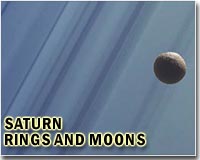 |
San Antonio TX (SPX) Dec 13, 2010 Simulations performed at Southwest Research Institute may explain how Saturn's majestic rings and icy inner moons formed following the collision of a Titan-sized satellite with the planet, according to a paper published in Nature magazine's Advance Online Publication. Saturn's rings are at present 90 to 95 percent water ice. Because dust and debris from rocky meteoroids have polluted the rings, the rings are believed to have consisted of pure ice when they formed. This composition is unusual compared to the approximately half-ice and half-rock mixture expected for materials in the outer Solar System. Similarly, the low densities of Saturn's inner moons show that they too are, as a group, unusually rich in ice. The previous leading ring origin theory suggests the rings formed when a small satellite was disrupted by an impacting comet. "This scenario would have likely resulted in rings that were a mixture of rock and ice, rather than the ice-rich rings we see today," says the paper's author, Dr. Robin M. Canup, associate vice president of the SwRI Planetary Science Directorate in Boulder, Colorado. The new theory links the formation of the rings to the formation of Saturn's satellites. While Jupiter has four large satellites, Saturn has only one, Titan. Previous work suggests that multiple Titan-sized satellites originally formed at Saturn, but that those orbiting interior to Titan were lost as their orbits spiraled into the planet. As the final lost satellite neared Saturn, heating caused by the flexing of its shape by the planet's gravity would cause its ice to melt and its rock to sink to its center. Canup uses numerical simulations to show that as such a satellite crosses the region of the current B ring, planetary tidal forces strip material from its outer icy layers, while its rocky core remains intact and eventually collides with the planet. This produces an initial ice ring that is much more massive than Saturn's current rings. Over time, collisions in the ring cause it to spread radially and decrease in mass. Inwardly spreading ring material is lost, while material spreading past the ring's outer edge accumulates into icy moons with estimated masses consistent with the inner moons seen today. "The new model proposes that the rings are primordial, formed from the same events that left Titan as Saturn's sole large satellite, " says Canup. "The implication is that the rings and the Saturnian moons interior to and including Tethys share a coupled origin, and are the last remnants of a lost companion satellite to Titan." During its extended mission, the Cassini spacecraft will measure the rings' current mass and will indirectly measure the pollution rate of the rings. This should provide an improved estimate of the rings' age and a test of the new ring origin model. NASA's Outer Planets Research Program funded this research. The paper, "Origin of Saturn's Rings and Inner Moons by Mass Removal from a Lost Titan-Sized Satellite," by Dr. R.M. Canup, was published in Nature magazine's Dec. 12 Advance Online Publication.
Share This Article With Planet Earth
Related Links Southwest Research Institute Explore The Ring World of Saturn and her moons Jupiter and its Moons The million outer planets of a star called Sol News Flash at Mercury
 Oxygen detected on Saturn moon
Oxygen detected on Saturn moonPasadena, Calif. (UPI) Nov 26, 2010 NASA's Cassini space probe orbiting Saturn has found evidence of an atmosphere on Rhea, one of the ringed planet's moons, U.S. researchers say. The spacecraft has detected a very thin atmosphere containing oxygen and carbon dioxide around the icy moon, a NASA release said Friday. This marks the first instance of a spacecraft directly capturing molecules of an oxygen atmosphere -- ... read more |
|
| The content herein, unless otherwise known to be public domain, are Copyright 1995-2010 - SpaceDaily. AFP and UPI Wire Stories are copyright Agence France-Presse and United Press International. ESA Portal Reports are copyright European Space Agency. All NASA sourced material is public domain. Additional copyrights may apply in whole or part to other bona fide parties. Advertising does not imply endorsement,agreement or approval of any opinions, statements or information provided by SpaceDaily on any Web page published or hosted by SpaceDaily. Privacy Statement |